Dynamic Simulation and Optimization of Off-Grid Hybrid Power Systems for Sustainable Rural Development
Abstract
1. Introduction
- The projected HPS is designed with PVsyst and HOMER Pro software. This entails identifying system loss, the ideal capacity, and the setup of elements to fulfill the power requirements of a system. The procedure encompasses investigating the load profile, evaluating the accessibility of renewable resources, integrating energy storage capacity, establishing the generator capacity, and employing a control system.
- Utilizing MATLAB Simulink r2023b, the dynamic modeling of the suggested hybrid power system is performed to assess its HPS behavior, voltage fluctuations, system load effects, and the quality of generated power across various settings, all tailored towards the selected site. The practical validation of the designed HPS is being performed by the OPAL-RT OP5707XG HIL real-time simulator.
- The decreases in CO2 emissions through energy production from the hybrid power system contribute to environmental preservation, thereby lowering the likelihood of floods in Pakistan.
2. Site Selection and Description
2.1. Solar Horizontal Irradiance
2.2. Analysis of Electrical Load
3. Designing of Hybrid Power System
3.1. Overview and Mathematical Modeling of Elements in the Hybrid Power System
3.1.1. Photovoltaic Structure
3.1.2. Buck Converter (DC-DC)
3.1.3. Maximum Power Point Track Control
3.1.4. LCL Filter
3.1.5. DC-AC Inverter
4. Performance Analysis and Optimization of the intended Hybrid Power System
4.1. Performance Analysis of System Using PVsyst Software
4.2. Orientation
4.3. Simulation in PVsyst
4.4. HOMER Pro Simulation and Optimization
5. Dynamic Modeling of Proposed Hybrid Power System in MATLAB Simulink
6. Experimental Validation Using Hardware in Loop
7. Findings
- Considering the recent floods in Pakistan, attributed largely to climate change induced by greenhouse gas emissions from fossil fuels, there is an urgent call for transitioning to renewable energy sources with minimal greenhouse gas emissions. Leveraging Pakistan’s ample solar global horizontal irradiance, solar photovoltaic systems play a crucial role in bolstering the electricity output of hybrid power systems. This addresses the specific energy needs of such facilities while amplifying economic advantages, thereby making advancements consistent with broader energy sustainability goals.
- Using HOMER Pro, 982 simulations were conducted, resulting in an optimal system with a renewable energy fraction of 100%.
- The hybrid power system’s energy cost is USD 0.158, resulting in substantial savings of USD 0.902 in contrast to the present expenses of USD 1.06. Additionally, the system’s annual operating cost of USD 2093 signifies significant savings of USD 5207 in contrast to the current cost of USD 7300.
8. Conclusions
Author Contributions
Funding
Data Availability Statement
Conflicts of Interest
References
- Akhtar, S.; Hashmi, M.K.; Ahmad, I.; Raza, R. Advances and significance of solar reflectors in solar energy technology in Pakistan. Energy Environ. 2018, 29, 435–455. [Google Scholar] [CrossRef]
- Bakht, M.P.; Salam, Z.; Bhatti, A.R.; Ullah Sheikh, U.; Khan, N.; Anjum, W. Techno-economic modelling of hybrid energy system to overcome the load shedding problem: A case study of Pakistan. PLoS ONE 2022, 17, e0266660. [Google Scholar] [CrossRef]
- Ahmed, M.R.; Hasan, M.R.; Al Hasan, S.; Aziz, M.; Hoque, M.E. Feasibility Study of the Grid-Connected Hybrid Energy System for Supplying Electricity to Support the Health and Education Sector in the Metropolitan Area. Energies 2023, 16, 1571. [Google Scholar] [CrossRef]
- Martins, F.; Felgueiras, C.; Smitkova, M.; Caetano, N. Analysis of Fossil Fuel Energy Consumption and Environmental Impacts in European Countries. Energies 2019, 12, 964. [Google Scholar] [CrossRef]
- Richardson, M.; Cowtan, K.; Millar, R.J. Global temperature definition affects achievement of long-term climate goals. Environ. Res. Lett. 2018, 13, 054004. [Google Scholar] [CrossRef]
- Bölük, G.; Mert, M. Fossil & renewable energy consumption, GHGs (greenhouse gases) and economic growth: Evidence from a panel of EU (European Union) countries. Energy 2014, 74, 439–446. [Google Scholar] [CrossRef]
- Al-Ketan, O. Potential of using olive pomace as a source of renewable energy for electricity generation in the Kingdom of Jordan. J. Renew. Sustain. Energy 2012, 4, 063132. [Google Scholar] [CrossRef]
- Malik, S.; Qasim, M.; Saeed, H.; Chang, Y.; Taghizadeh-Hesary, F. Energy security in Pakistan: Perspectives and policy implications from a quantitative analysis. Energy Policy 2020, 144, 111552. [Google Scholar] [CrossRef]
- Lin, B.; Raza, M.Y. Analysis of energy related CO2 emissions in Pakistan. J. Clean. Prod. 2019, 219, 981–993. [Google Scholar] [CrossRef]
- Naeem, M.K.; Anwar, S.; Nasreen, S. Empirical analysis of CO2 emissions and sustainable use of energy sources in Pakistan. Environ. Sci. Pollut. Res. 2021, 28, 16420–16433. [Google Scholar] [CrossRef]
- Sohoo, I.; Ritzkowski, M.; Kuchta, K.; Cinar, S.Ö. Environmental Sustainability Enhancement of Waste Disposal Sites in Developing Countries through Controlling Greenhouse Gas Emissions. Sustainability 2020, 13, 151. [Google Scholar] [CrossRef]
- Asian Development Bank. The Impact of Infrastructure Investment on Inclusive Growth and Poverty Reduction: A Review. Available online: https://www.adb.org/sites/default/files/publication/535821/adbi-wp1024.pdf (accessed on 2 May 2024).
- Alifu, H.; Hirabayashi, Y.; Imada, Y.; Shiogama, H. Enhancement of river flooding due to global warming. Sci. Rep. 2022, 12, 20687. [Google Scholar] [CrossRef]
- Shehzad, K. Extreme flood in Pakistan: Is Pakistan paying the cost of climate change? A short communication. Sci. Total Environ. 2023, 880, 162973. [Google Scholar] [CrossRef]
- Manzoor, Z.; Ehsan, M.; Khan, M.B.; Manzoor, A.; Akhter, M.M.; Sohail, M.T.; Hussain, A.; Shafi, A.; Abu-Alam, T.; Abioui, M. Floods and flood management and its socio-economic impact on Pakistan: A review of the empirical literature. Front. Environ. Sci. 2022, 10, 1021862. [Google Scholar] [CrossRef]
- Khayyam, U.; Noureen, S. Assessing the adverse effects of flooding for the livelihood of the poor and the level of external response: A case study of Hazara Division, Pakistan. Environ. Sci. Pollut. Res. 2020, 27, 19638–19649. [Google Scholar] [CrossRef]
- Qudrat-Ullah, H. A review and analysis of renewable energy policies and CO2 emissions of Pakistan. Energy 2022, 238, 121849. [Google Scholar] [CrossRef]
- Zafar, U.; Ur Rashid, T.; Khosa, A.A.; Khalil, M.S.; Rashid, M. An overview of implemented renewable energy policy of Pakistan. Renew. Sustain. Energy Rev. 2018, 82, 654–665. [Google Scholar] [CrossRef]
- Guo, S.; Liu, Q.; Sun, J.; Jin, H. A review on the utilization of hybrid renewable energy. Renew. Sustain. Energy Rev. 2018, 91, 1121–1147. [Google Scholar] [CrossRef]
- Ji, L.; Liang, X.; Xie, Y.; Huang, G.; Wang, B. Optimal design and sensitivity analysis of the stand-alone hybrid energy system with PV and biomass-CHP for remote villages. Energy 2021, 225, 120323. [Google Scholar] [CrossRef]
- Hussain, F.; Maeng, S.-J.; Cheema, M.J.M.; Anjum, M.N.; Afzal, A.; Azam, M.; Wu, R.-S.; Noor, R.S.; Umair, M.; Iqbal, T. Solar Irrigation Potential, Key Issues and Challenges in Pakistan. Water 2023, 15, 1727. [Google Scholar] [CrossRef]
- Tamoor, M.; Bhatti, A.R.; Farhan, M.; Miran, S. Design of On-Grid Photovoltaic System Considering Optimized Sizing of Photovoltaic Modules for Enhancing Output Energy. Eng. Proc. 2022, 19, 2. [Google Scholar] [CrossRef]
- Nawab, F.; Abd Hamid, A.S.; Arif, M.; Khan, T.A.; Naveed, A.; Sadiq, M.; Imad Ud Din, S.; Ibrahim, A. Solar–Biogas Microgrid: A Strategy for the Sustainable Development of Rural Communities in Pakistan. Sustainability 2022, 14, 11124. [Google Scholar] [CrossRef]
- Iqbal, A.; Iqbal, M.T. Design and Analysis of a Stand-Alone PV System for a Rural House in Pakistan. Int. J. Photoenergy 2019, 2019, 1–8. [Google Scholar] [CrossRef]
- Xu, L.; Wang, Y.; Solangi, Y.; Zameer, H.; Shah, S. Off-Grid Solar PV Power Generation System in Sindh, Pakistan: A Techno-Economic Feasibility Analysis. Processes 2019, 7, 308. [Google Scholar] [CrossRef]
- Ur Rehman, A.; Iqbal, M.T. Design and Control of an Off-Grid Solar System for a Rural House in Pakistan. In Proceedings of the 2020 11th IEEE Annual Information Technology, Electronics and Mobile Communication Conference (IEMCON), IEEE, Vancouver, BC, Canada, 4–7 November 2020; pp. 0786–0790. [Google Scholar] [CrossRef]
- Elsaraf, H.; Jamil, M.; Pandey, B. Techno-Economic Design of a Combined Heat and Power Microgrid for a Remote Community in Newfoundland Canada. IEEE Access 2021, 9, 91548–91563. [Google Scholar] [CrossRef]
- Kumar, K.; Kumar, M.; Soomro, A.M. To Design an off Gird PV System for un electrified area of District Tharparkar, Pakistan. Int. J. Green Energy 2021, 18, 920–932. [Google Scholar] [CrossRef]
- Ali, F.; Ahmar, M.; Jiang, Y.; AlAhmad, M. A techno-economic assessment of hybrid energy systems in rural Pakistan. Energy 2021, 215, 119103. [Google Scholar] [CrossRef]
- Rehmani, A.M.; Akhter, P. Techno-Economic analysis of hybrid renewable energy systems for rural area energization in Pakistan. In Proceedings of the 2019 3rd International Conference on Energy Conservation and Efficiency (ICECE), IEEE, Lahore, Pakistan, 23–24 October 2019; pp. 1–6. [Google Scholar]
- Abdullah, F.B.; Iqbal, R.; Jawaid, M.; Ahmad, S. Addressing unaccounted-for-gas (UFG): Proactive techniques for optimal management and control. Energy Strategy Rev. 2024, 53, 101397. [Google Scholar] [CrossRef]
- Qazi, U.; Jahanzaib, M. An integrated sectoral framework for the development of sustainable power sector in Pakistan. Energy Rep. 2018, 4, 376–392. [Google Scholar] [CrossRef]
- Dhimish, M.; Silvestre, S. Estimating the impact of azimuth-angle variations on photovoltaic annual energy production. Clean Energy 2019, 3, 47–58. [Google Scholar] [CrossRef]
- Solaris. Solar Resource Information and PV Power Potential. Available online: https://apps.solargis.com/prospect/detail/3IirckDVsvHfKB5n/info (accessed on 2 May 2024).
- Wang, Z.; Crawley, J.; Li, F.G.N.; Lowe, R. Sizing of district heating systems based on smart meter data: Quantifying the aggregated domestic energy demand and demand diversity in the UK. Energy 2020, 193, 116780. [Google Scholar] [CrossRef]
- Al-Shahri, O.A.; Ismail, F.B.; Hannan, M.A.; Lipu, M.S.H.; Al-Shetwi, A.Q.; Begum, R.A.; Al-Muhsen, N.F.O.; Soujeri, E. Solar photovoltaic energy optimization methods, challenges and issues: A comprehensive review. J. Clean. Prod. 2021, 284, 125465. [Google Scholar] [CrossRef]
- Podder, A.K.; Roy, N.K.; Pota, H.R. MPPT methods for solar PV systems: A critical review based on tracking nature. IET Renew Power Gener. 2019, 13, 1615–1632. [Google Scholar] [CrossRef]
- Madhukumar, M.; Suresh, T.; Jamil, M. Investigation of Photovoltaic Grid System under Non-Uniform Irradiance Conditions. Electronics 2020, 9, 1512. [Google Scholar] [CrossRef]
- Cai, Y.; He, Y.; Zhou, H.; Liu, J. Design Method of LCL Filter for Grid-Connected Inverter Based on Particle Swarm Optimization and Screening Method. IEEE Trans. Power Electron. 2021, 36, 10097–10113. [Google Scholar] [CrossRef]
- Baqir, M.; Channi, H.K. Analysis and design of solar PV system using Pvsyst software. Mater. Today Proc. 2022, 48, 1332–1338. [Google Scholar] [CrossRef]


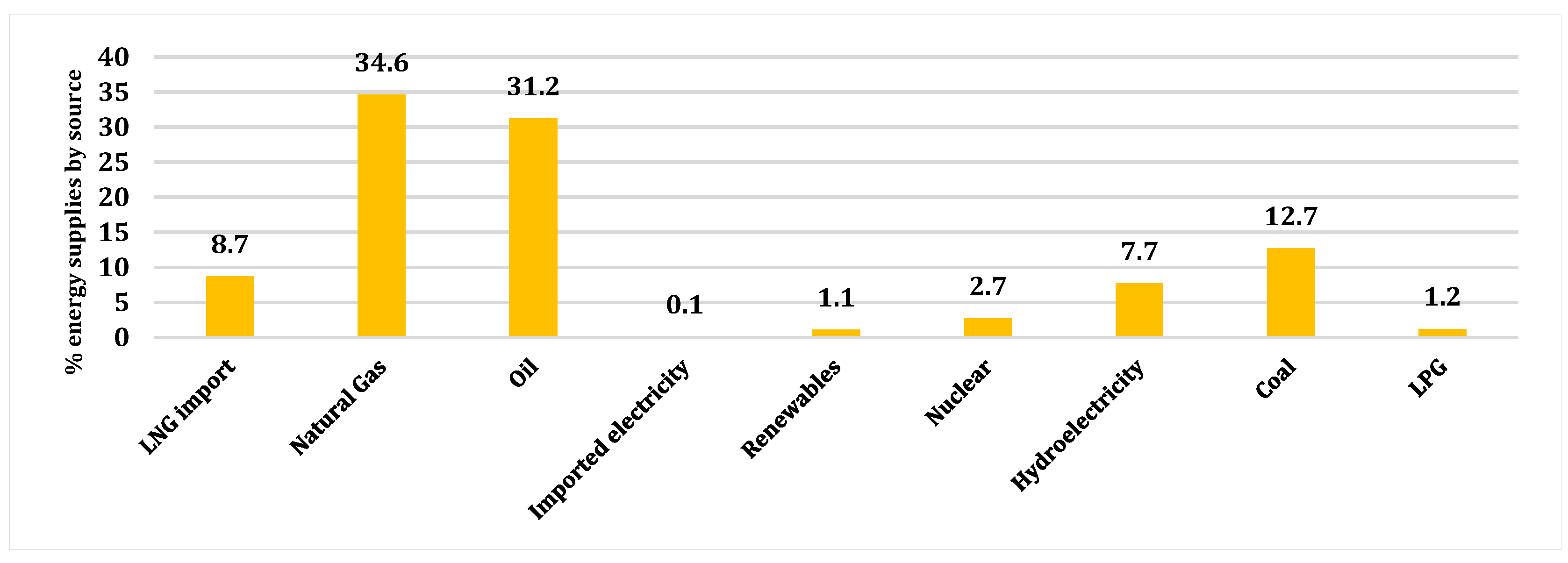
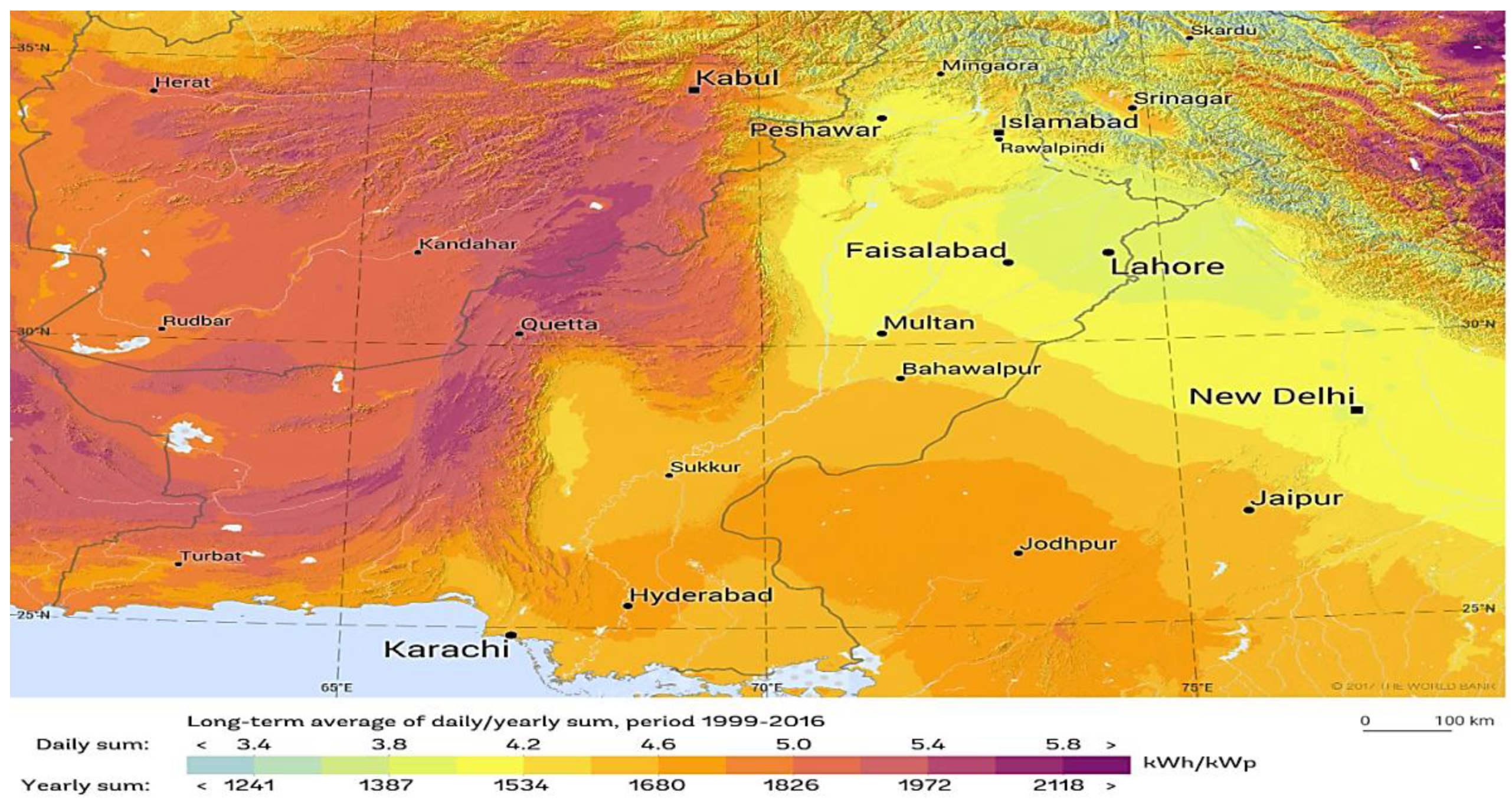

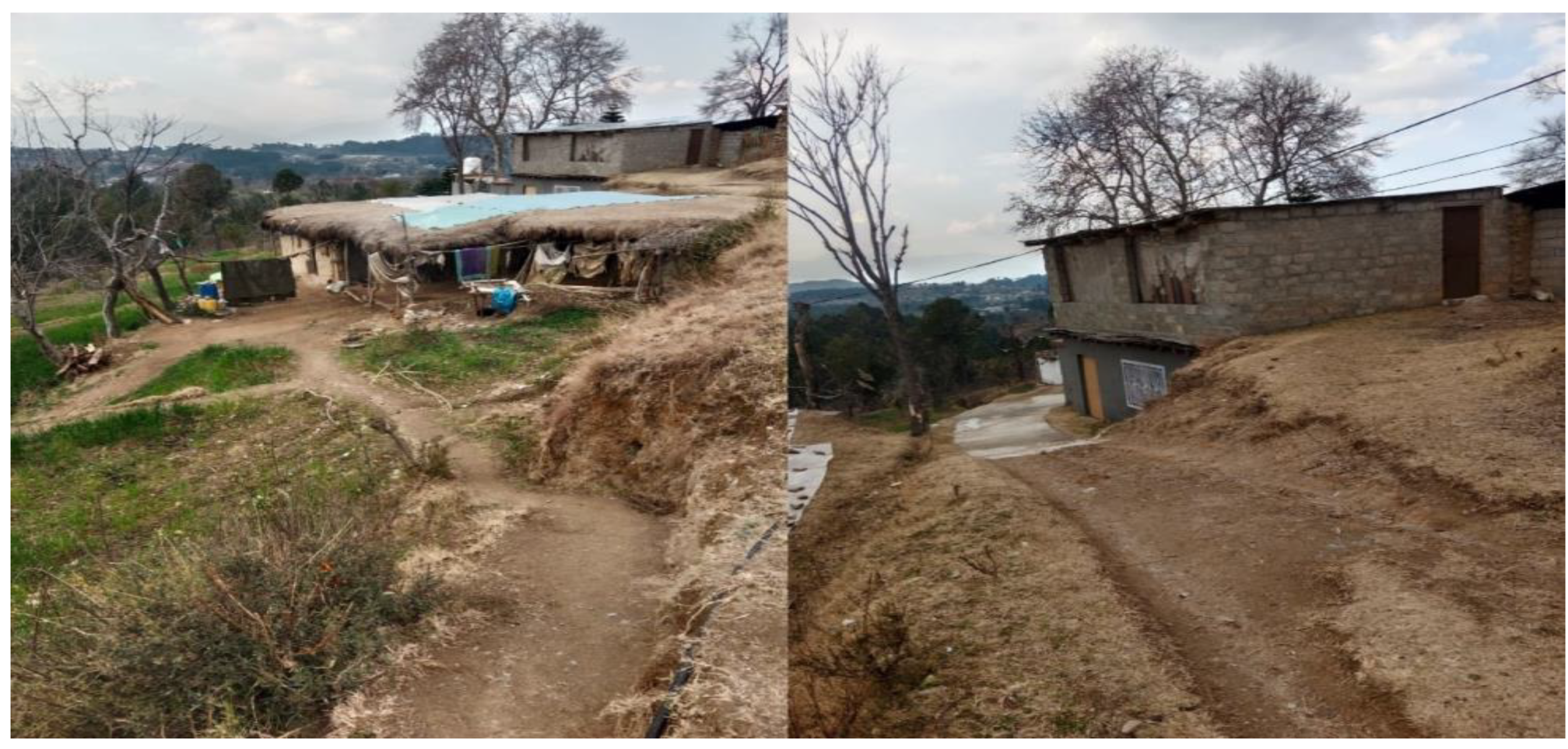


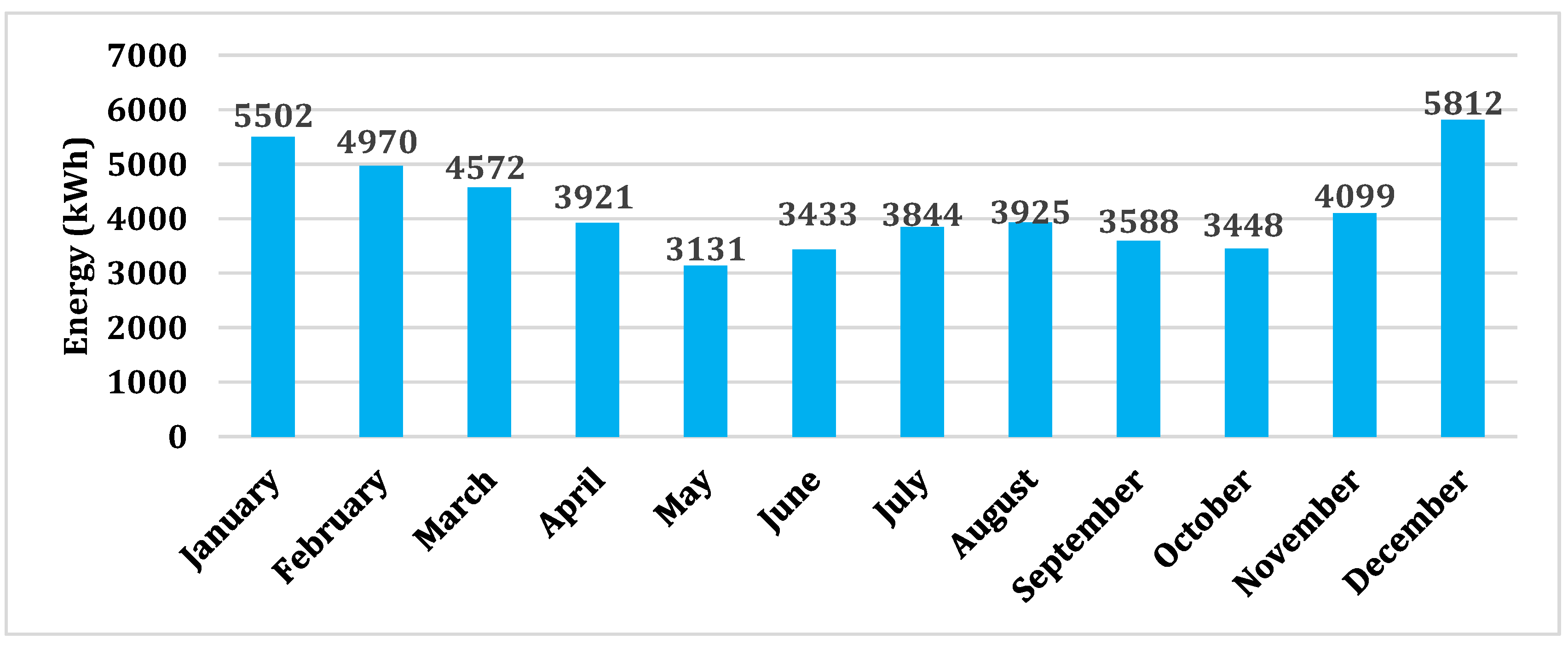
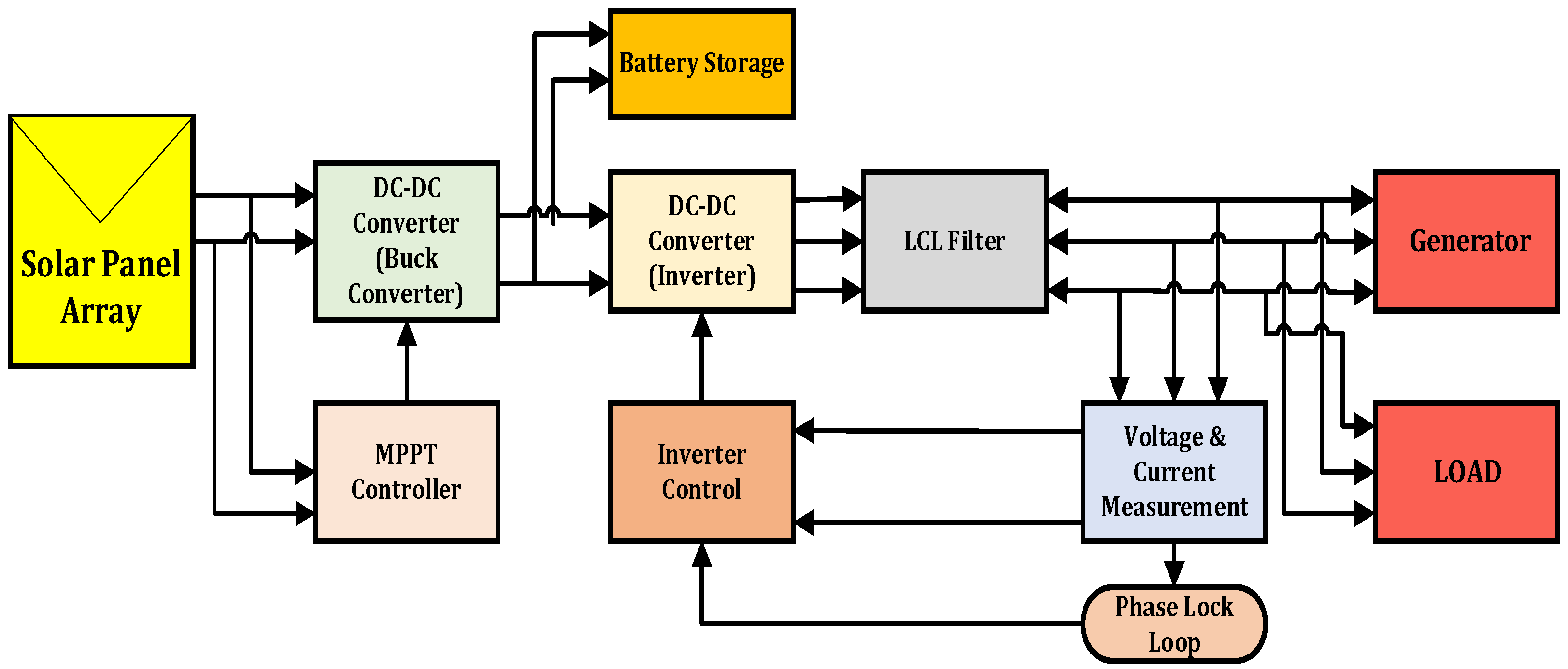
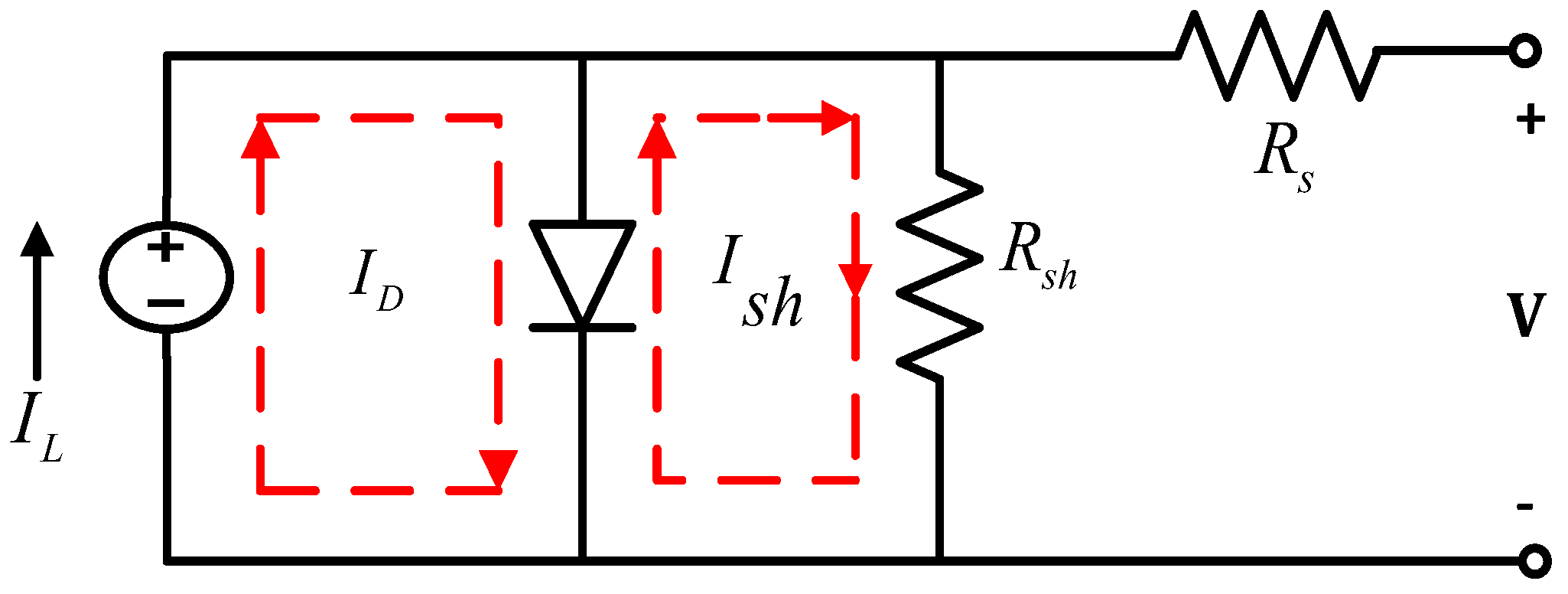

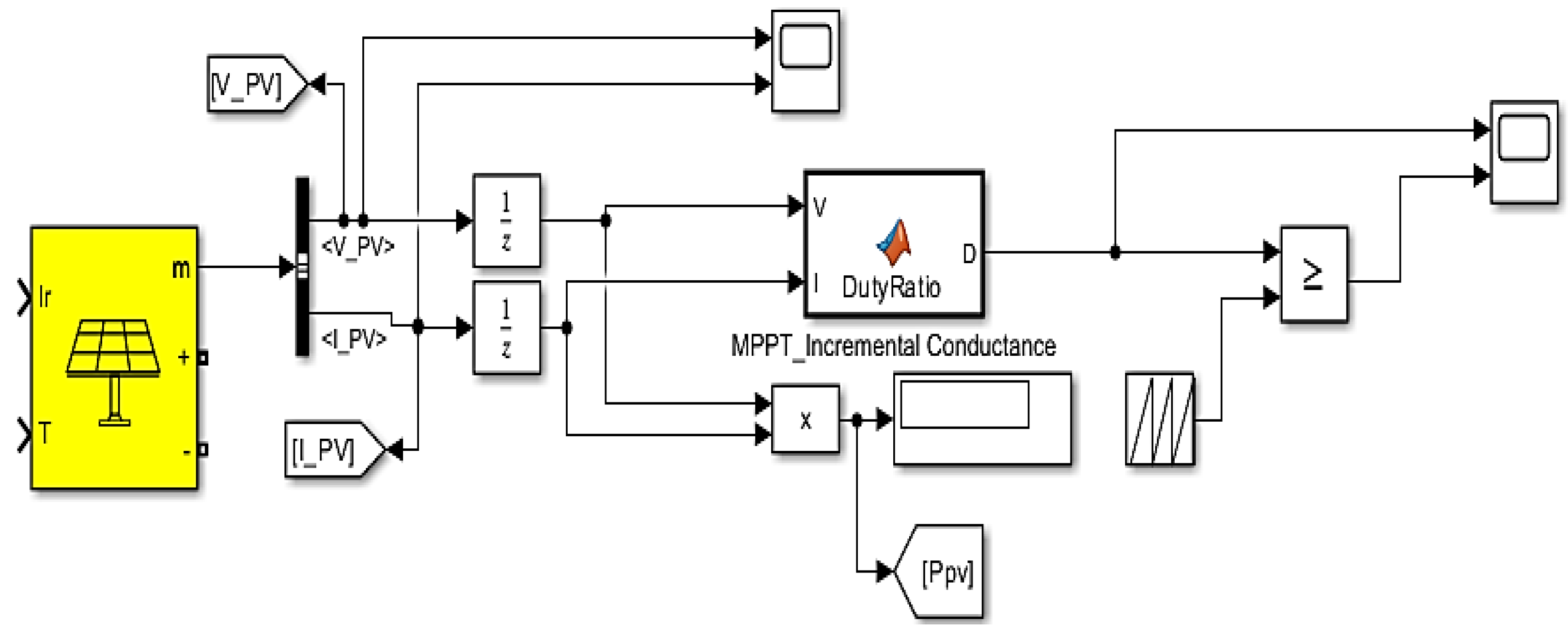
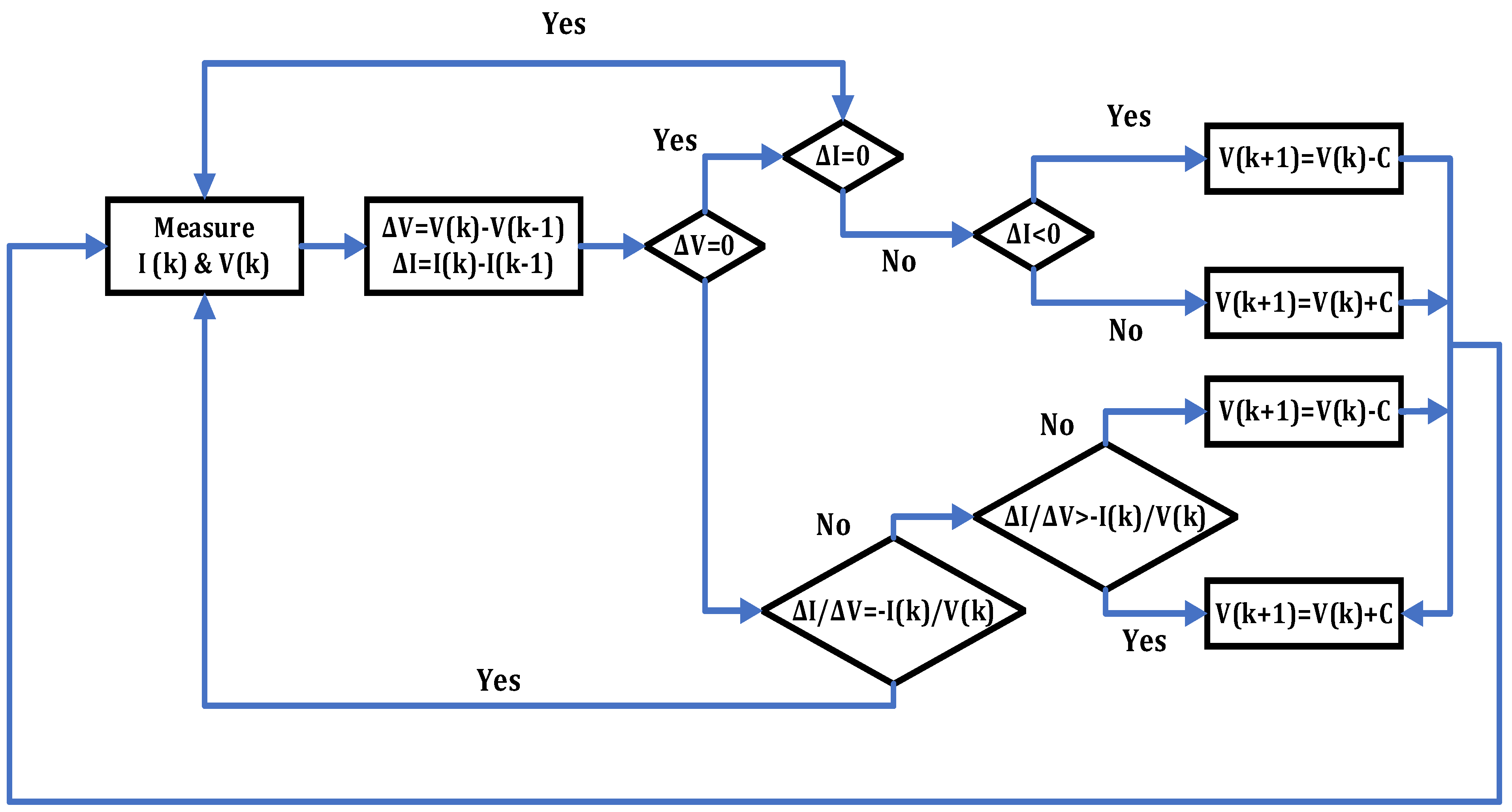



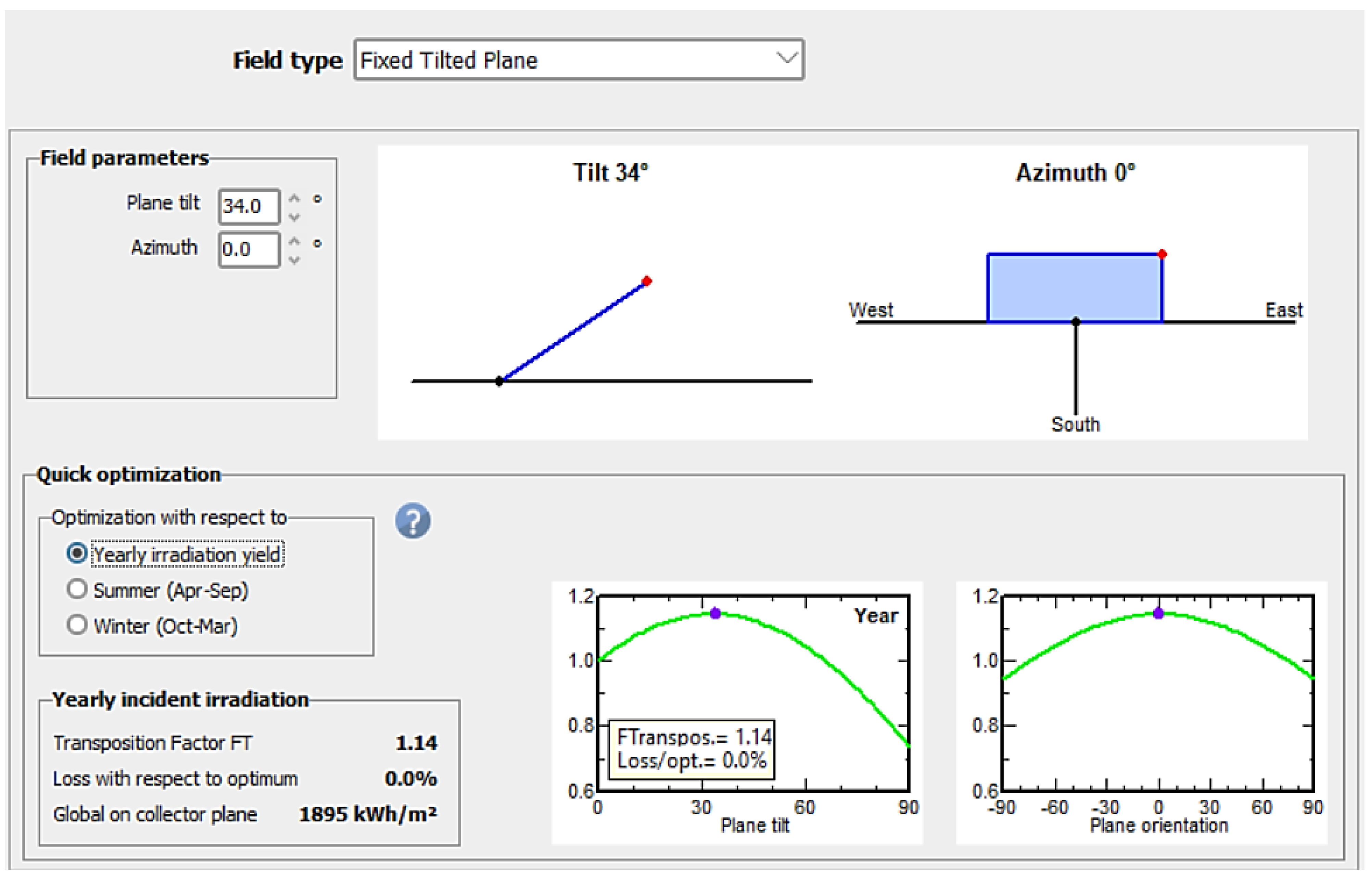


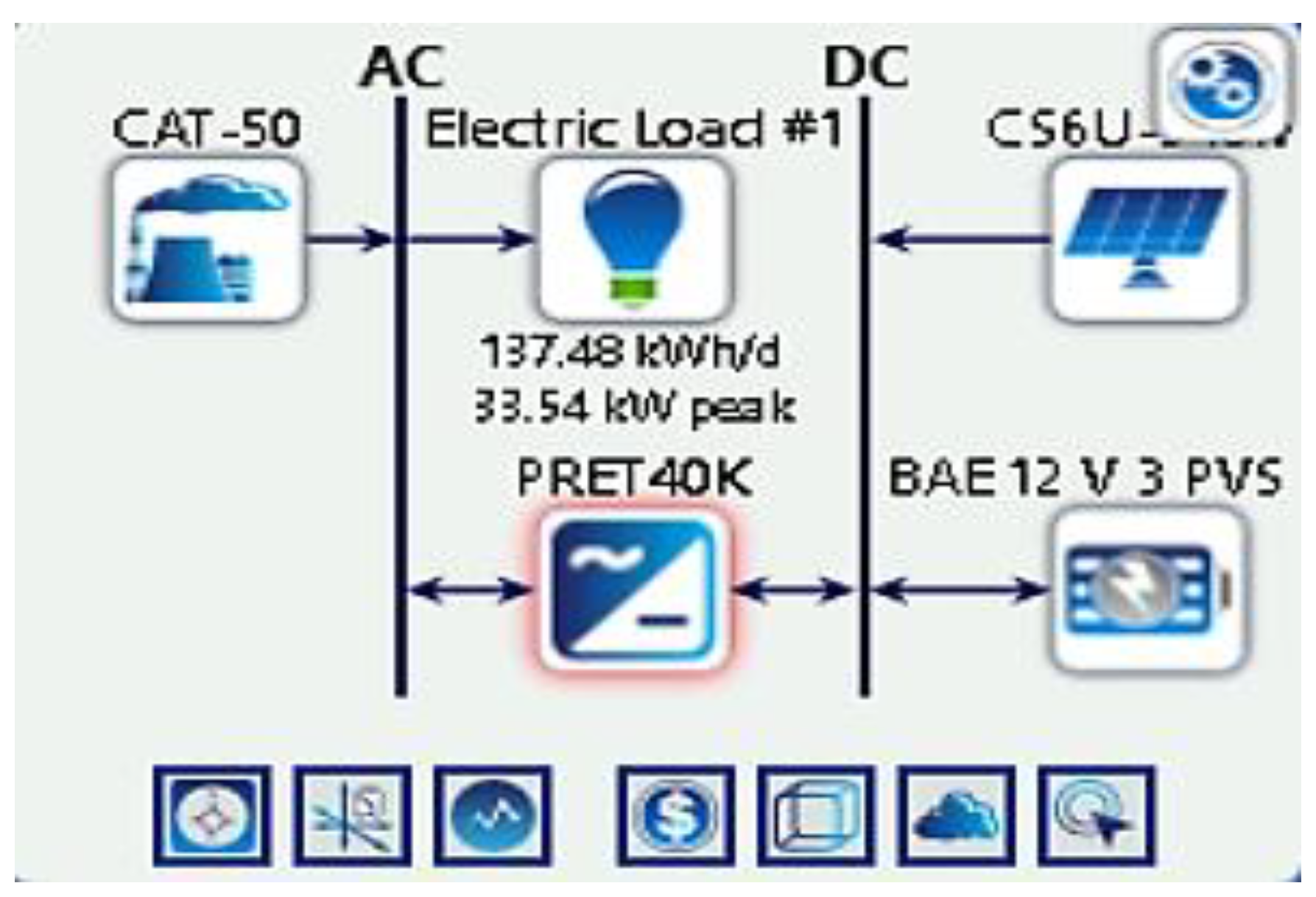
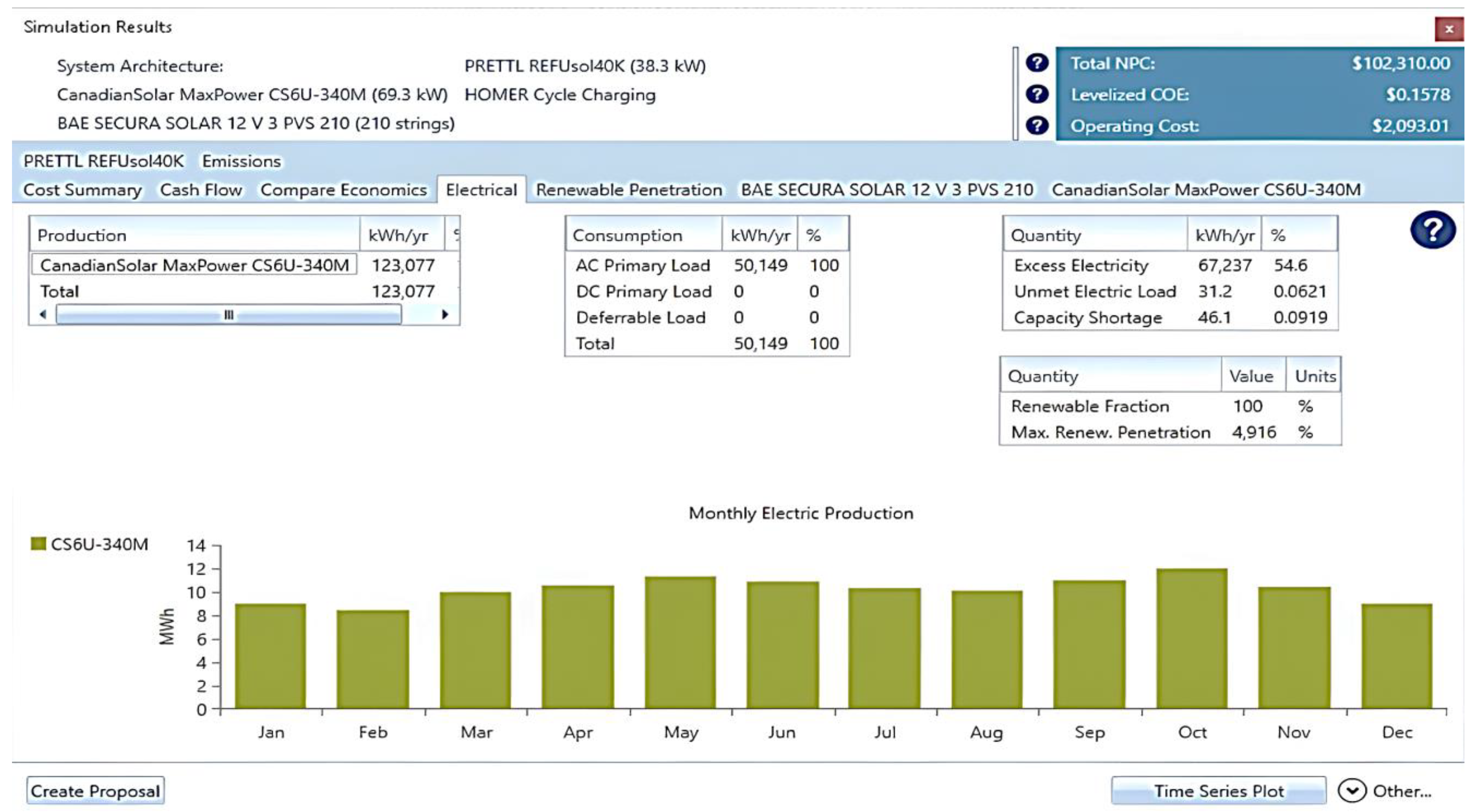


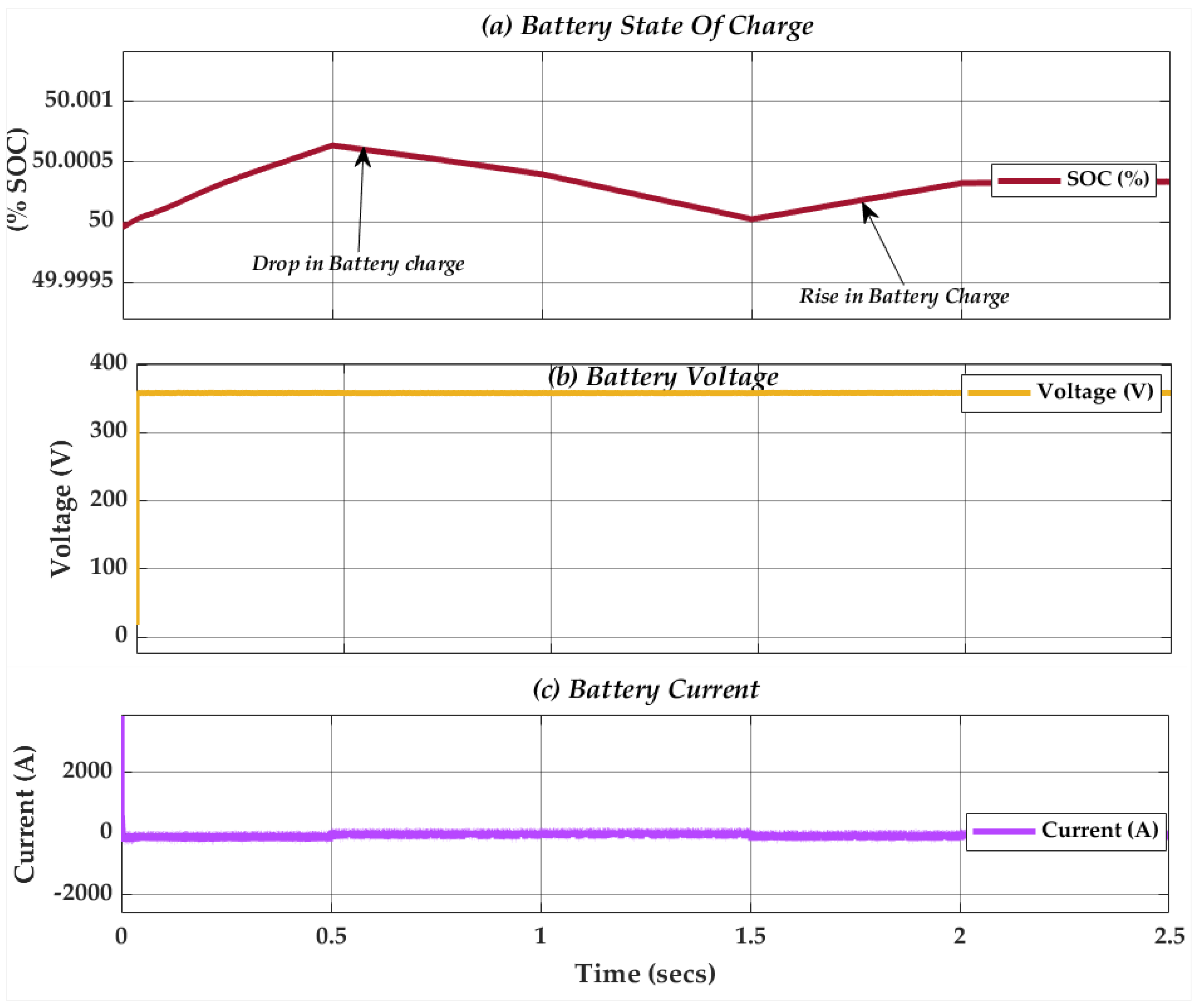
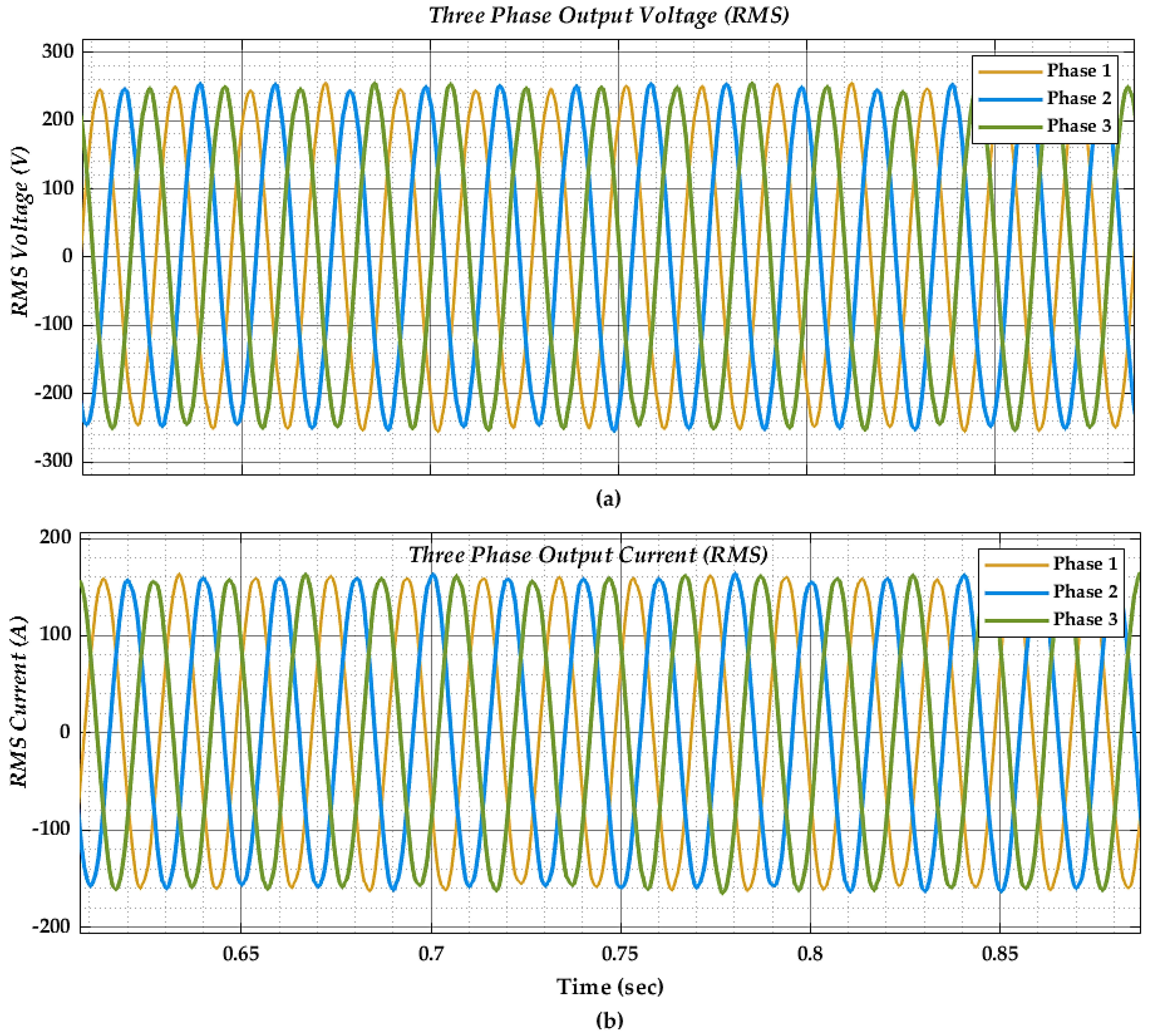


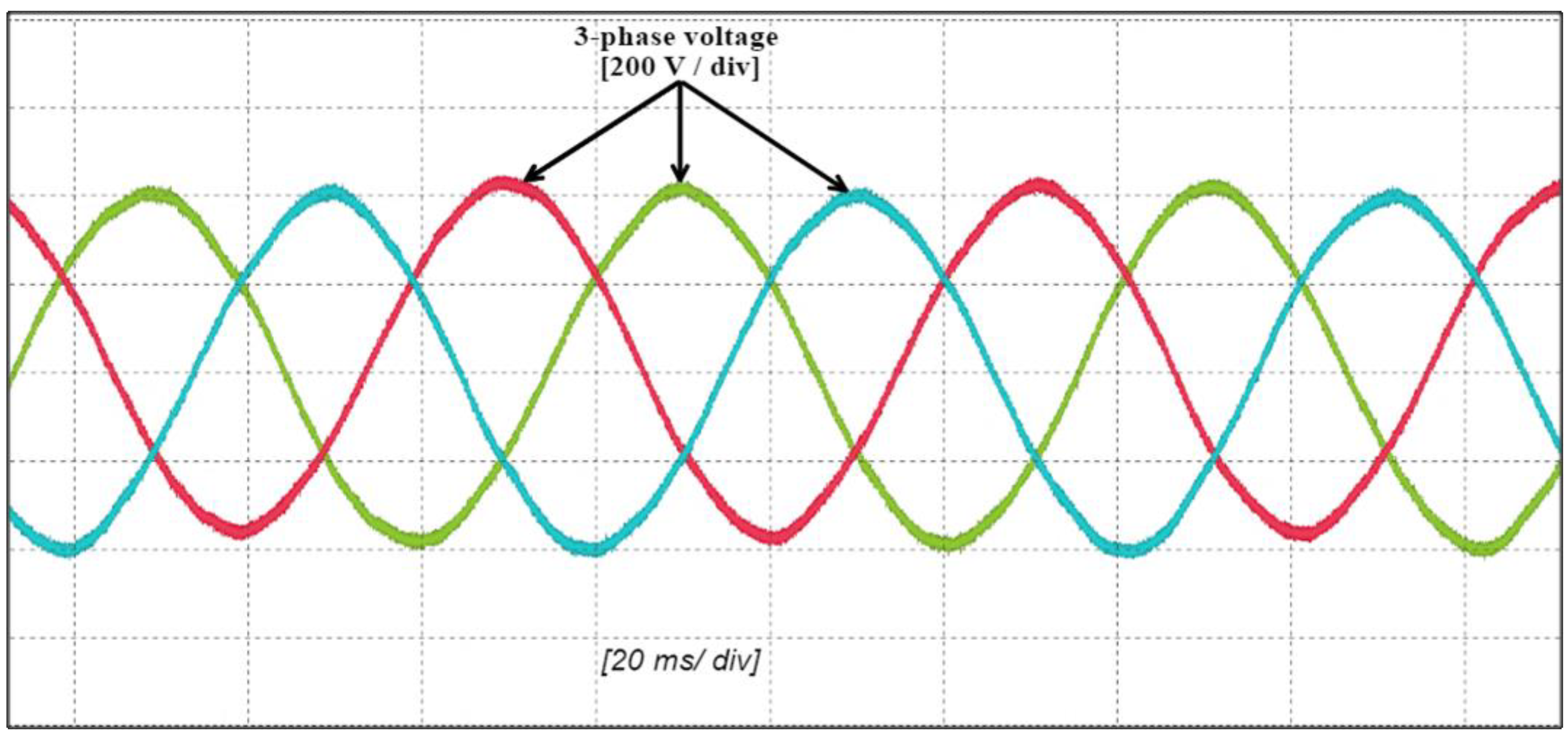

| Province | Damage (Million USD) | Loss (Million USD) | Requirement for Rehabilitation (Million USD) |
|---|---|---|---|
| Baluchistan | 1625 | 2516 | 2286 |
| KPK (Khyber Pakhtunkhwa) | 935 | 658 | 780 |
| Punjab | 515 | 566 | 746 |
| Sindh | 9068 | 11,376 | 7860 |
| Appliances Description | Unit’s Quantity | Installed Unit Load Rated Power | Aggregate Connected Load |
|---|---|---|---|
| Watts (W) | (KW) | ||
| LED Lights | 100 | 30 | 3 |
| Ceiling Fan | 30 | 75 | 2.25 |
| Iron | 8 | 1000 | 8 |
| Washing Machine | 10 | 700 | 7 |
| Refrigerator | 10 | 750 | 7.5 |
| Television | 10 | 200 | 2 |
| Electric Heater | 8 | 500 | 4 |
| Electric Geyser | 8 | 1000 | 8 |
| Water Suction Pump | 1 | 5000 | 5 |
| Total Connected Load | 46.75 KW | ||
| Condition | Setting Point | Results Achieved |
|---|---|---|
| MPP = P | Functioning at MPP | |
| MPP > P | The operational point is set to the maximum power point (MPP) | |
| MPP < P | The operational point aligns with the maximum power point (MPP) |
| Month | GlobHor [kWh/m2] | GlobEff [kWh/m2] | Diff Hor [kWh/m2] | E Array [kWh] | E User [kWh] | Unused Energy [kWh] | Fuel BU [Liters] |
|---|---|---|---|---|---|---|---|
| January | 70.7 | 105.4 | 29.42 | 4418 | 2556 | 1935 | 542 |
| February | 85.3 | 107.6 | 45.44 | 4510 | 2462 | 1948 | 452 |
| March | 123.8 | 138.4 | 67.86 | 5799 | 2868 | 2643 | 470 |
| April | 163.7 | 165.7 | 68.20 | 6943 | 2802 | 3479 | 439 |
| May | 197 | 179.2 | 78.54 | 7510 | 2978 | 3634 | 433 |
| June | 199.2 | 173.8 | 78 | 7282 | 2949 | 3410 | 413 |
| July | 183.8 | 163.8 | 90.40 | 6865 | 3057 | 2895 | 425 |
| August | 175.4 | 170 | 82.13 | 7125 | 2967 | 3268 | 447 |
| September | 161.9 | 179.6 | 59.60 | 7524 | 2881 | 3696 | 437 |
| October | 134.2 | 176.9 | 41.38 | 7413 | 2818 | 3855 | 481 |
| November | 85.2 | 124 | 34.35 | 5198 | 2507 | 2572 | 493 |
| December | 78.1 | 126.9 | 27.16 | 5316 | 2571 | 2600 | 519 |
| Total | 1658.3 | 1811.3 | 702.48 | 75,903 | 33,416 | 35,953 | 5551 |
| Model | BAE Secura |
|---|---|
| Abbreviation | BAE 12 |
| Nominal Voltage (V) | 12 |
| Nominal Capacity (kWh) | 2.41 |
| Maximum Capacity (Ah) | 201 |
| Rate Constant (1/h) | 2.09 |
| Roundtrip Efficiency (%) | 85 |
| Maximum Charge Current (A) | 68.4 |
| Maximum Discharge Current (A) | 342 |
| Maximum Charge Rate (A/Ah) | 1 |
| Model | Canadian Solar Max Power |
|---|---|
| Abbreviation | CS6U-3 |
| Nominal Max. Power (W) (Pmax) | 340 |
| Opt. Voltage (Vmp) | 32.6 |
| Opt. Current (A) (Imp) | 10.43 |
| Open Circuit Voltage (Voc) | 39.6 |
| Short Circuit Current (Isc) | 10.98 |
| Module Efficiency (%) | 18.4 |
| Cell Type | Poly-crystalline |
| Operating Temperature | −40 °C~+85 °C |
| Component Description | Capital (USD) | Replacement (USD) | OM (USD) | Total (USD) |
|---|---|---|---|---|
| BAE SECURA SOLAR 12 V3 PVS 210 | 37,800 | 0 | 13,573.89 | 51,373.89 |
| Canadian solar Maxpower CS6U-340M | 36,685.92 | 0 | 13,173.79 | 49,859.71 |
| PRETTL REFUso 40K | 766.66 | 0 | 309.74 | 1076.4 |
| Total | 75,253 | 0 | 27,057.42 | 102,310 |
| System Structure | Solar Panel (kW) | Diesel Genset (kW) | Battery Bank (No.) | Converter (kW) | NPC (USD) | COE (USD) | Operating Expenses (USD/Year) | Primary Investment (USD) |
|---|---|---|---|---|---|---|---|---|
| PV-BB-Converter | 69.3 | 210 | 38.3 | 0.102 M | 0.158 | 2093 | 75,253 | |
| PV-Genset-BB-Converter | 60.5 | 40 | 187 | 38.1 | 0.104 M | 0.161 | 2391 | 73,452 |
| PV-Genset-Converter | 300 | 40 | 40.4 | 1.70 M | 2.62 | 118,520 | 166,710 | |
| Genset | 40 | 40.4 | 2.44 M | 3.77 | 188,407 | 166,710 |
| Solar Irradiance (kWh/m2/day) | System Design | PV (kW) | Diesel Genset (kW) | Battery Bank (No. of Batteries) | Converter (Kw) | NPC (USD) | COE (USD/kWh) | Operating Cost (USD/year) | Initial Capital (USD) | Renewable Energy Fraction (%) | CO2 Emissions (kg/year) |
|---|---|---|---|---|---|---|---|---|---|---|---|
| 0 | DG | 0 | 40 | 0 | 0 | 12.1 M | 18.60 | 931,949 | 17,014 | 0 | 102,531 |
| 1 | PV-DG-BB-Converter | 404 | 40 | 216 | 45.6 | 371,294 | 0.572 | 8540 | 260,896 | 99.7 | 184 |
| 2 | PV-BB-Converter | 197 | 0 | 260 | 90.3 | 207,804 | 0.320 | 4252 | 152,839 | 100 | 0 |
| 3 | PV-BB-Converter | 115 | 0 | 273 | 122 | 152,857 | 0.236 | 3130 | 112,839 | 100 | 0 |
| 4 | PV-BB-Converter | 93.3 | 0 | 227 | 90 | 125,222 | 0.193 | 2564 | 92,077 | 100 | 0 |
| 5.08 | PV-BB-Converter | 69.3 | 0 | 210 | 38.3 | 102,310 | 0.158 | 2093 | 75,253 | 100 | 0 |
| 6 | PV-BB-Converter | 67.3 | 0 | 180 | 72.1 | 94,518 | 0.146 | 1935 | 69,497 | 100 | 0 |
| 7 | PV-BB-Converter | 55.5 | 0 | 176 | 54.5 | 84,533 | 0.130 | 1731 | 62,162 | 100 | 0 |
| 8 | PV-BB-Converter | 44.1 | 0 | 183 | 65.1 | 78,358 | 0.121 | 1605 | 57,612 | 100 | 0 |
| 9 | PV-BB-Converter | 40.8 | 0 | 176 | 61.9 | 74,174 | 0.114 | 1519 | 54,535 | 100 | 0 |
| 10 | PV-BB-Converter | 49.2 | 0 | 136 | 73.7 | 70,747 | 0.109 | 1450 | 52,006 | 100 | 0 |
| 11 | PV-BB-Converter | 43 | 0 | 136 | 64.9 | 66,039 | 0.102 | 1353 | 48,547 | 100 | 0 |
| Time (Seconds) | Solar GHI (W/m2) | Temprtaure (°C) |
|---|---|---|
| 0 | 1000 | 25 |
| 0.5 | 400 | 25 |
| 1 | 400 | 35 |
| 1.5 | 1000 | 35 |
| 2 | 1000 | 45 |
| 2.5 | 1000 | 45 |
Disclaimer/Publisher’s Note: The statements, opinions and data contained in all publications are solely those of the individual author(s) and contributor(s) and not of MDPI and/or the editor(s). MDPI and/or the editor(s) disclaim responsibility for any injury to people or property resulting from any ideas, methods, instructions or products referred to in the content. |
© 2024 by the authors. Licensee MDPI, Basel, Switzerland. This article is an open access article distributed under the terms and conditions of the Creative Commons Attribution (CC BY) license (https://creativecommons.org/licenses/by/4.0/).
Share and Cite
Khalid, W.; Awais, Q.; Jamil, M.; Khan, A.A. Dynamic Simulation and Optimization of Off-Grid Hybrid Power Systems for Sustainable Rural Development. Electronics 2024, 13, 2487. https://doi.org/10.3390/electronics13132487
Khalid W, Awais Q, Jamil M, Khan AA. Dynamic Simulation and Optimization of Off-Grid Hybrid Power Systems for Sustainable Rural Development. Electronics. 2024; 13(13):2487. https://doi.org/10.3390/electronics13132487
Chicago/Turabian StyleKhalid, Wajahat, Qasim Awais, Mohsin Jamil, and Ashraf Ali Khan. 2024. "Dynamic Simulation and Optimization of Off-Grid Hybrid Power Systems for Sustainable Rural Development" Electronics 13, no. 13: 2487. https://doi.org/10.3390/electronics13132487
APA StyleKhalid, W., Awais, Q., Jamil, M., & Khan, A. A. (2024). Dynamic Simulation and Optimization of Off-Grid Hybrid Power Systems for Sustainable Rural Development. Electronics, 13(13), 2487. https://doi.org/10.3390/electronics13132487







